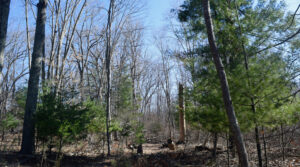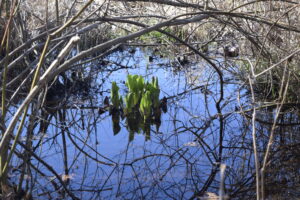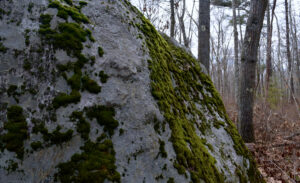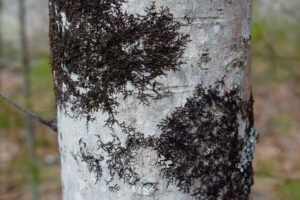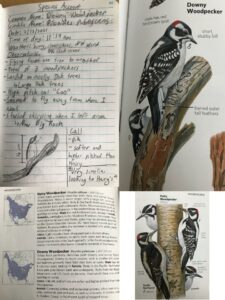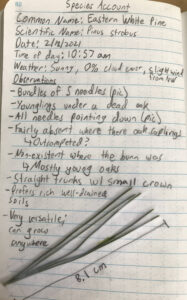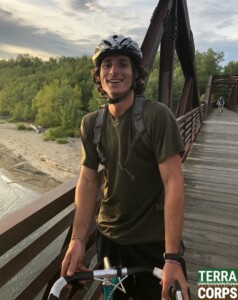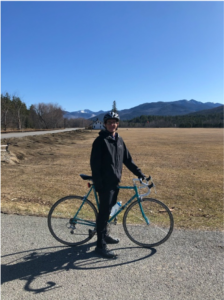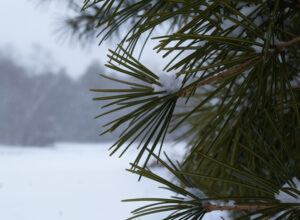The O’Donnell Preserve has been an ongoing project for the Attleboro Land Trust since 2015. A few years ago, a trail was established and cut by a group of volunteers. Their work completed about 75% of the trail but there was still an unknown final section. This final section was surrounded by wetlands so it was tough terrain for a trail. There was a surprise for us though! A small patch of dry land with a stand of beech and black gum trees presented itself to us. We called this spot Beech Point.
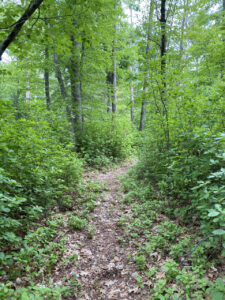
Section of the trail where there is an abundance of blueberry and huckleberry bushes.
Fast forward to 2021, and we have all of the pieces falling together. I was transitioning to land stewardship work as I entered into the second half of my service term. It was time to tackle the O’Donnell Preserve project. Our timeline was tight as we were hoping to open the preserve in a short two months, but we were determined to do so! My first task was to complete a natural communities assessment of the property to compliment the baseline documentation report. This report is used to see how the property changes over time in order to better monitor the health of the preserve. Another component to opening the preserve was to create a management plan that addresses the potential issues that the property may face in the future like invasive species, flooding, and erosion. In this management plan, invasives were a big part of it as the northeastern corner of the property is filled with them. The ground was disturbed there in the past meaning it was a perfect habitat for invasives to establish themselves. With the management plan completed, the next step was the most exciting one: establish and cut the final section of trail!
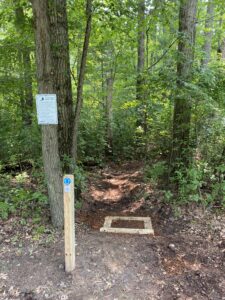
Entrance of the O’Donnell Preserve.
In order to complete this, we first needed to establish where we wanted the trail to go. We looked at the aerial imagery with the wetlands layer toggled on to get a sense of the area. You can clearly see Beech Point because of the peninsula it creates within the wetlands. It is a perfect section of dry land to put a trail on. We had our trail in mind so we set out onto the property. As we walked down the already cut trail, we realized that the many years of neglect left the trail overgrown and in need of maintenance. It was added to our to-do list. We made it to the end of the pre-existing trail and began marking the new section. Pink flagging tape was placed where we thought the best place for the trail was. Finally, we made it to Beech Point where the massive beech trees towered over us. We decided that a small loop around Beech Point made the most sense. We were now ready to go!
Up until this point, there were only two or three of us working on this project. We were now moving into trail work and needed to call in our backup: the volunteers! With pruners, saws, chainsaws, shears, post-hole diggers, shovels, rakes, weed whackers, and scythes, our volunteers were ready to take on this project. I set out in front leading the pack behind me. I directed a few volunteers to start the trail maintenance on the pre-existing trail in order to get it back to its original glory and away they went on their mission. The rest of the group followed me to Beech Point where most of the work was to be done. The loop trail needed serious work including trimming the branches, removing tripping hazards and removing small plants on the trail. After a quick 3 hours, the trail started to come into focus. Their tireless effort was essential for the success of this project as we needed to move quickly in order to meet the deadline we set for ourselves. At the end of the day, the entire trail was nearly complete!
As with every project, there are always obstacles that come up. One obstacle for us was the realization that the first 150 feet of the trail was on city property! This meant we needed to cut a new entrance that was on ALT property so about 50 feet to the east of the original entrance. We needed our backup again! With no complaints and only excitement, our volunteers were ready for the task. Within three hours, the new trail was cut and trimmed. It looked amazing!

Mike Davis (left) and Bill Luther (right) installing steps.
Our final work party involved creating one step, placing down wood chips at the entrance trail, and installing the O’Donnell entrance sign. The installation of the O’Donnell sign was no easy task as each leg stands at 11 feet and weighs a lot, but it was no match against the volunteers that showed up that day. The work party began with one crew placing wood chips along the trail, another digging the holes for the entrance sign, and a final group creating the steps. After a few hours, the trail was filling in nicely as the wood chips replaced the squishy, uneven ground that posed a walking hazard to anyone exploring the property. This hard work required a lot of effort but was completely worth it in the end. The steps were assembled and made the trail more accessible for hikers. We gathered our full volunteer force for the final step to install the entrance sign. With five or six of us holding the sign in place, we ensured that it was level and ready for the cement. The cement was poured in along with the water. Within only a few minutes, the cement was already setting, and the sign was installed! What an amazing sight to see! After two months of hard work to get this preserve open, we were finally seeing the finished product!
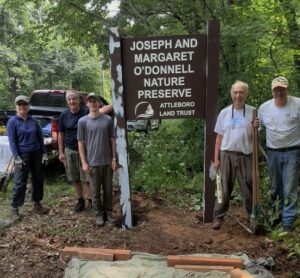
Group of volunteers who helped install the entrance sign.
I can’t thank the ALT volunteers enough for all of the work that they put into opening this preserve to the public. It is because of you that all Attleboro residents can enjoy the natural environment and explore nature right in their backyard. What an amazing gift to give someone! Always remember the hard work that you put into this project and be proud of it! And finally, a huge thank you to all the volunteers that I was able to work with. I tried to remember everyone that I worked with but please forgive me if I forgot your name… I still appreciate you! Continue the amazing work that you all are doing and always remember the gift that you are giving to the Attleboro community! Best of luck to the ALT!
Thank you to all of you:
Phil Boucher, Kim Goff, Ken Drucker, Russ Prey, Mike Davis, Charlie Adler, Bonnie Moore, Elaine Rivera, Gary Krofta, Bill Luther, Brian Hatch, Tony Conca, Bill Lewis, Dave Rolince, Susan Davis, Cait Bamberry, Gabby Dias, Rick Lewis, Cliff Ennis, Dick Cheyne, Alan Henry, Monica O’Melia, Bruce Ingram, Bob Martin, Ross Mulcare

